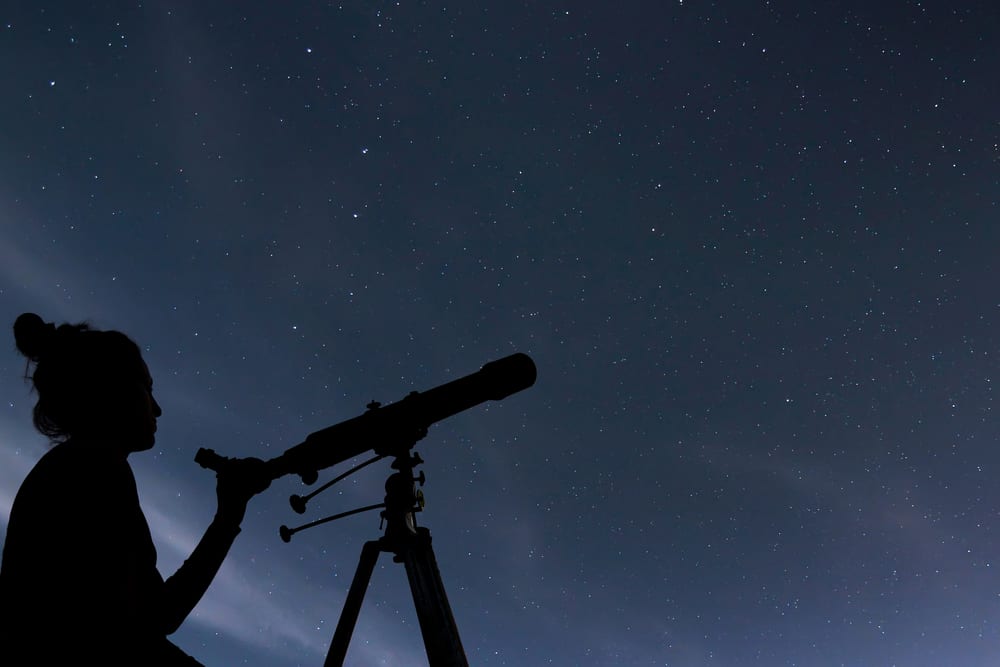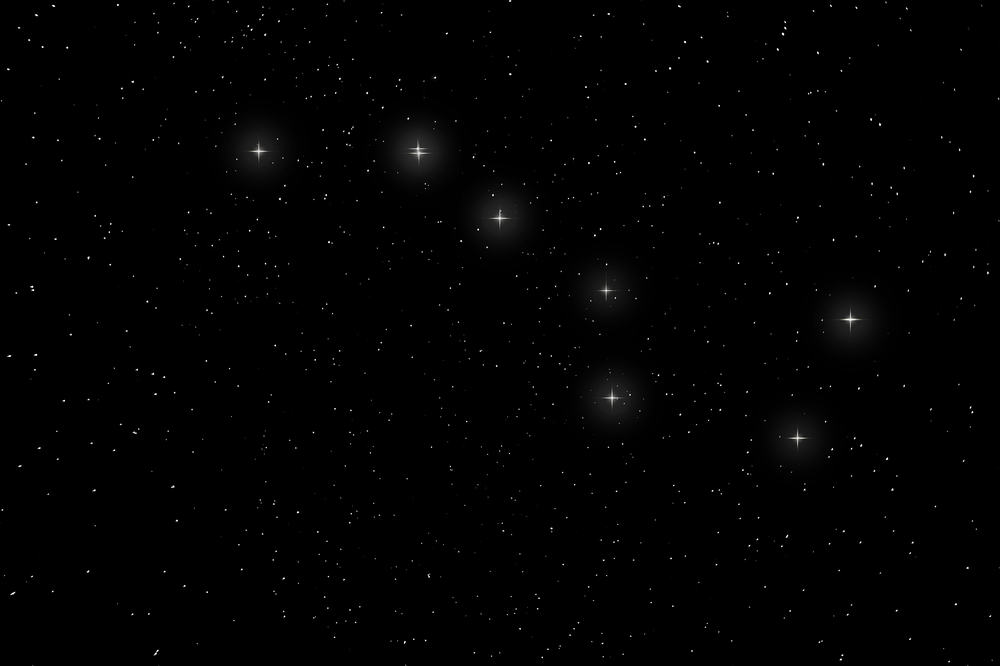
Have you wondered how to get started with stargazing in Raleigh and the rest of the Triangle? You’ll have a great start with this guide written by Xiao-Ming Porter, an undergraduate student employee at Morehead Planetarium and Science Center at UNC Chapel Hill.
Learn where to go for skywatching or stargazing, what to look for in the sky, tools that will help you identify what you’re seeing, major upcoming astronomical events, how to spot the International Space Station, and more. Finally, check out the list of upcoming guided skywatching events in the Triangle.
If you’d like to just see a list of upcoming events, you can jump to that section.
Where should I go for skywatching in the Triangle?
- You’ll see more stars if you get far away from city lights. This may involve driving 30-60 minutes away from any larger towns.
- Many public parks (such as Little River Regional Park or Eno River State Park) close at dusk, so check their hours beforehand.
- Designated campgrounds will be open at night during specific seasons.
- Some public locations to check out include: Jordan Lake State Recreation Area, Falls Lake State Recreation Area, or Old Bynum Bridge. Again, always check if they are open.
- Take care not to trespass on private property.
What makes a good night for skywatching?
A cloudless, moonless night. Unless you’re specifically trying for a view of the full moon, you’ll get a darker sky and more stars with a crescent or new moon.
I don’t know much about astronomy. What resources should I use?
- Stellarium is free, open-source software that you can download onto a computer. It can show you the night sky from any location at any time, and zoom in on features there.
- Many phone apps let you point your phone at the sky as if taking a picture, and the screen will display information about that portion of the sky. It’s great for identifying constellations and planets. A few of these include: SkySafari, SkyView, and Night Sky.
How do I see the International Space Station?
The ISS can pass overhead pretty frequently, sometimes up to several times in one night. It will look like a bright, steadily shining star that moves. To see when the ISS will pass through your sky, enter your location into spotthestation.nasa.gov.
Do I need a telescope / binoculars?
No, you don’t need fancy equipment to have a great time skywatching. There’s plenty to see with just the naked eye.
Now, amateur astronomy doesn’t have to be an expensive hobby. A decent pair of astronomy binoculars can be found for as little as 50 bucks, and are great for looking at the moon, planets, and even some of the brighter star clusters. A great amateur telescope can run from 100-300 dollars. With proper storage and care, these can last many years.
If you want to look through a telescope but don’t want to purchase one, attend some public skywatching events organized by Morehead Planetarium or a local astronomy club. Keep reading! We have a list of upcoming guided skywatching events at the end of this article.

Which constellations are easiest to identify?
In the spring:
- Big Dipper (part of the constellation Ursa Major)
- Leo the lion
- Virgo the maiden
In the summer:
- Scorpius the scorpion
- Sagittarius the centaur (look for the “Sagittarius teapot”)
- Lyra the lyre
- Cygnus the swan
- Aquila the eagle
In the fall:
- Casseiopeia the queen
- Pegasus the flying horse
- Andromeda the princess
In the winter:
- Orion the hunter
- Taurus the bull
- Canis Major and Canis Minor, the big dog and little dog
- Gemini the twins
If you’re not familiar with these constellations, this is a great time to use one of those phone apps like SkySafari, SkyView, or Night Sky!
What’s special about the constellations that relate to the Zodiac?
The Zodiac constellations are along the path the Sun takes throughout the year, and they’re also where planets are found in the sky! If you can recognize the Zodiac, then any unfamiliar bright “stars” in one of those constellations are likely planets.
Careful! The Western Zodiac originates from Babylonian times. In the 2000-something years since it was invented, the Earth has precessed, or “wobbled” along its axis, shifting the sun’s path along these constellations. The constellation the Sun was in on your birthday is most likely not the same as your Zodiac sign, at least the one you look up on the internet.
Which stars are easiest to identify from the Triangle?
- Polaris (the North Star): visible all year round, and always due North.
- Arcturus: brightest star in the spring/summer sky. Slightly red in hue.
- Spica: more blue in hue, and highest in the spring. In the constellation Virgo.
- Antares: distinctly red, low in the Southern sky during the summer. Frequently mistaken for Mars. It is the “heart” of the Scorpius constellation.
- Deneb, Vega, and Altair: known as the “Summer Triangle,” these are three really bright stars that form a large triangle straddling the Milky Way. Vega is the brightest.
- Orion’s Belt: visible in the winter, three bright stars close together in a line. Part of the constellation Orion, easily the most widely recognized constellation.
- Sirius: visible in the winter, Sirius is the brightest star in the sky. Nicknamed the “Dog Star.” Find it by extending Orion’s belt to the left.
- Betelgeuse: visible in winter, a distinctly red star in Orion’s shoulder on the left side.
- Aldebaran: a very red star visible in the winter. Known as the “eye” of Taurus the bull constellation. Find it by extending Orion’s belt to the right.
I have a telescope / binoculars. What should I look at?

Planets
In particular:
- Venus: Large and bright, usually visible in the late evening or early morning. From April to September, 2024, it will be visible in the morning sky. From September 20 to Deceuberm 31, it will be visible in the evening sky. Through a telescope, you should be able to observe phases, similar to the moon.
- Mars: Appears distinctly red or orange. Will be visible in the morning sky through the end of 2024, getting brighter toward the end of the y ear.
- Jupiter: Quite bright, and through a telescope you should see cloud bands on the surface and up to four moons around it – the Galilean moons. From May to November, 2024, it will be visible in the morning sky.
- Saturn: Appears slightly elongated because of its rings, and with good enough magnification you can make out the rings distinctly. Starting in the fall, it will be available in the evening.
Moon
Many astronomers prefer viewing a half-moon or crescent. At these times, the line between the light and dark side of the moon will be visible, and will cast shadows on craters and surface texture.
Andromeda
Our nearest large neighbor galaxy. It is barely visible with the naked eye, and will look more clear through a telescope. Located in the Andromeda constellation, high overhead in the fall.
Messier Objects
The Messier Catalog is a list of 110 bright astronomical objects, and is a great place to start. Look up a list of “brightest Messier objects,” and you’ll have a busy night of observing ahead! My personal favorites are the Pleiades star cluster, Orion nebula, and Ring nebula.
What astronomical events will happen in the rest of 2024?

Meteor Showers
Times when you are most likely to see a “shooting star.” These look like bright stars that streak quickly across the sky, visible only for a few seconds.
- Quadrantids | January 3–4, 2024
- Lyrids | April 21–22, 2024
- Eta Aquarids | May 4–5, 2024
- Delta Aquarids | July 29–30, 2024
- Perseids | August 11–13, 2024
- Draconids | October 8-9, 2024
- Orionids | October 21–22, 2024
- Leonids | November 17–18, 2024

Eclipses
Lunar eclipses are when the moon passes through the Earth’s shadow. Total lunar eclipses are not events you want to miss! At this time the moon appears red or orange, due to the way sunlight bends through Earth’s atmosphere – hence the nickname “blood moons.”
The next partial eclipse visible in America will be September 17-18, 2024. The next total lunar eclipse will be March 14, 2025.
Solar eclipses are when the moon passes in front of the Sun, blocking the Sun’s light. The next total solar eclipse visible in the contiguous United States will be on August 22, 2044.
For a more extensive list of astronomical events, visit https://www.timeanddate.com/astronomy/sights-to-see.html.
Be sure to check whether they’re visible from your location.
What’s a super moon?
Not that exciting. At some points in the moon’s orbit, it passes closer to the Earth. The difference in size is barely visible, if at all.
What organizations should I keep up with to learn about skywatching and astronomy?
Morehead Planetarium & Science Center, Raleigh Astronomy Club, and Chapel Hill Astronomical Observational Society all host public skywatching events, sometimes in collaboration with each other. These events are generally free, but may require registration. And keep reading for a list of upcoming skywatching events.
Learn more at:
